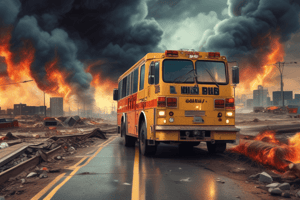Podcast
Questions and Answers
What is the primary responsibility of the Medical Group in the incident command system?
What is the primary responsibility of the Medical Group in the incident command system?
- Designating the staging area location and managing traffic congestion
- Coordinating the removal of bodies and identification of victims
- Appointing the branch supervisor during incidents
- Overseeing triage, treatment, and transport of patients (correct)
Who is responsible for counting and prioritizing patients during triage?
Who is responsible for counting and prioritizing patients during triage?
- Staging area manager
- Triage unit leader (correct)
- Rehabilitation group leader
- Treatment unit leader
What is the primary role of the treatment units?
What is the primary role of the treatment units?
- Designating the staging area location
- Removing bodies and identifying victims
- Coordinating transportation and distribution of patients to hospitals
- Setting up treatment areas and providing secondary triage (correct)
What is the primary responsibility of the rehabilitation group leader?
What is the primary responsibility of the rehabilitation group leader?
Who is responsible for releasing vehicles and supplies when needed?
Who is responsible for releasing vehicles and supplies when needed?
What incident command role may be appointed depending on the incident?
What incident command role may be appointed depending on the incident?
What is the primary responsibility of the Staging Officer during incident response?
What is the primary responsibility of the Staging Officer during incident response?
What is an essential component of preparedness?
What is an essential component of preparedness?
During scene size-up, what information does dispatch provide?
During scene size-up, what information does dispatch provide?
Who decides on demobilization of resources during an incident?
Who decides on demobilization of resources during an incident?
What is the primary goal of establishing command early on in an incident?
What is the primary goal of establishing command early on in an incident?
Why is face-to-face communication preferred in incident command and communication?
Why is face-to-face communication preferred in incident command and communication?
What should you do during scene size-up?
What should you do during scene size-up?
What should you do after receiving an initial briefing about the incident and job responsibilities?
What should you do after receiving an initial briefing about the incident and job responsibilities?
Flashcards are hidden until you start studying
Study Notes
Incident Response and Mobilization
- Once an incident is declared, additional resources and personnel are requested, mobilized, and deployed to a designated staging area.
- A staging officer is assigned to coordinate incoming and outgoing units, track units, and maintain accountability.
Mobilization and Deployment Steps
- Check in with the Incident Commander or resource unit at a large-scale incident.
- Receive an initial briefing about the incident and job responsibilities.
- Keep the supervisor up to date on location, actions, and completed/uncompleted tasks.
- The Incident Commander decides on demobilization of resources.
Preparedness
- Preparedness involves making decisions and basic plans before an incident occurs.
- Plans include all natural and human-made disasters likely to happen in a particular area.
- Each agency has a written disaster plan, usually located at the MS station or electronically accessible.
- Personal disaster plans and necessary immunizations are also important.
- Training is a crucial component of preparedness.
Scene Size-Up and Requesting Resources
- During scene size-up, dispatch informs you if the MCI scene is safe or unsafe.
- Request more resources early on if necessary.
- Ask yourself: "What do you have?" and "What do you need?"
- Check for hazards, warn other responders of safety concerns, and confirm the location of the incident.
- Estimate the number of casualties and report findings back to dispatch or supervisors.
Incident Command and Communication
- Establish command early on, preferably by the first arriving, most experienced Public Safety official.
- Evaluate the scene and return to your post if working as the Incident Commander.
- Communication is a problem at an MCI or disaster; use face-to-face communication when possible.
- Use reliable, durable, and tested communication equipment with backups.
Medical Group and Incident Command
- The Medical Group, formerly known as the Medical Incident Command, is the medical branch of the incident command system.
- A branch supervisor is appointed during incidents with a significant medical factor.
- The Medical Group oversees triage, treatment, and transport, and ensures EMS units work within the incident command system.
Triage, Treatment, and Transport
- The triage unit leader counts and prioritizes patients, ensuring each patient receives an initial assessment and triage.
- Treatment units set up treatment areas, provide secondary triage, and assist with moving patients to the transportation area.
- Treatment units communicate with the logistics section for supplies and request sufficient quantities.
- Transport units coordinate transportation and distribution of patients to appropriate hospitals.
Staging Area and Rehabilitation
- A staging area manager is assigned to designate an efficient location for the staging area, away from the incident.
- The staging area manager helps prevent traffic congestion and releases vehicles and supplies when needed.
- The rehabilitation group leader creates a rehab area for responders to rest, eat, and drink, and monitors personnel for signs of stress.
Other Incident Command Roles
- An extrication task force leader or rescue task force leader may be appointed depending on the incident.
- A morg unit leader coordinates the removal of bodies, identification of victims, and removal/storage plans in multiple fatality situations or crime scene investigations.
Incident Response and Mobilization
- Following incident declaration, additional resources and personnel are requested, mobilized, and deployed to a designated staging area.
- A staging officer coordinates incoming and outgoing units, tracks units, and maintains accountability.
Mobilization and Deployment Steps
- Check in with the Incident Commander or resource unit at a large-scale incident.
- Receive an initial briefing about the incident and job responsibilities.
- Keep the supervisor updated on location, actions, and completed/uncompleted tasks.
- The Incident Commander decides on demobilization of resources.
Preparedness
- Preparedness involves making decisions and basic plans before an incident occurs.
- Plans include all natural and human-made disasters likely to happen in a particular area.
- Each agency has a written disaster plan, usually located at the MS station or electronically accessible.
- Personal disaster plans and necessary immunizations are also important.
- Training is a crucial component of preparedness.
Scene Size-Up and Requesting Resources
- Dispatch informs responders about the safety of the MCI scene.
- Request additional resources early if necessary.
- Assess the scene by asking "What do you have?" and "What do you need?"
- Check for hazards, warn other responders of safety concerns, and confirm the location of the incident.
- Estimate the number of casualties and report findings back to dispatch or supervisors.
Incident Command and Communication
- Establish command early on, preferably by the first arriving, most experienced Public Safety official.
- Evaluate the scene and return to your post if working as the Incident Commander.
- Communication is a problem at an MCI or disaster; use face-to-face communication when possible.
- Use reliable, durable, and tested communication equipment with backups.
Medical Group and Incident Command
- The Medical Group oversees triage, treatment, and transport, and ensures EMS units work within the incident command system.
- A branch supervisor is appointed during incidents with a significant medical factor.
Triage, Treatment, and Transport
- The triage unit leader counts and prioritizes patients, ensuring each patient receives an initial assessment and triage.
- Treatment units set up treatment areas, provide secondary triage, and assist with moving patients to the transportation area.
- Treatment units communicate with the logistics section for supplies and request sufficient quantities.
- Transport units coordinate transportation and distribution of patients to appropriate hospitals.
Staging Area and Rehabilitation
- A staging area manager designates an efficient location for the staging area, away from the incident.
- The staging area manager helps prevent traffic congestion and releases vehicles and supplies when needed.
- The rehabilitation group leader creates a rehab area for responders to rest, eat, and drink, and monitors personnel for signs of stress.
Other Incident Command Roles
- An extrication task force leader or rescue task force leader may be appointed depending on the incident.
- A morg unit leader coordinates the removal of bodies, identification of victims, and removal/storage plans in multiple fatality situations or crime scene investigations.
Studying That Suits You
Use AI to generate personalized quizzes and flashcards to suit your learning preferences.




